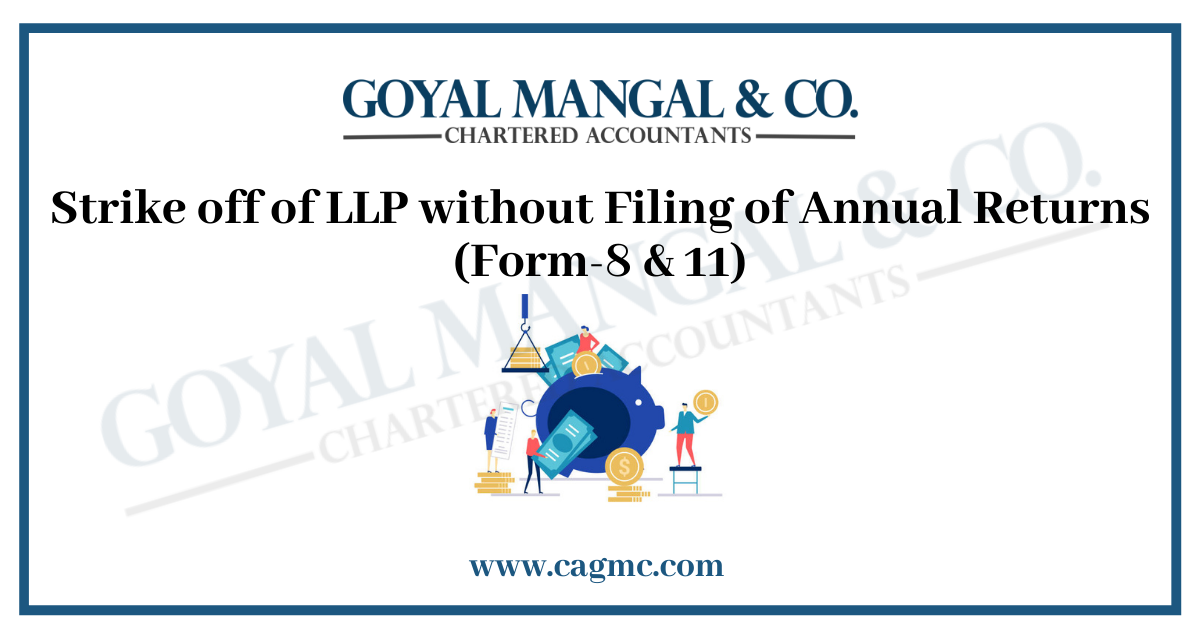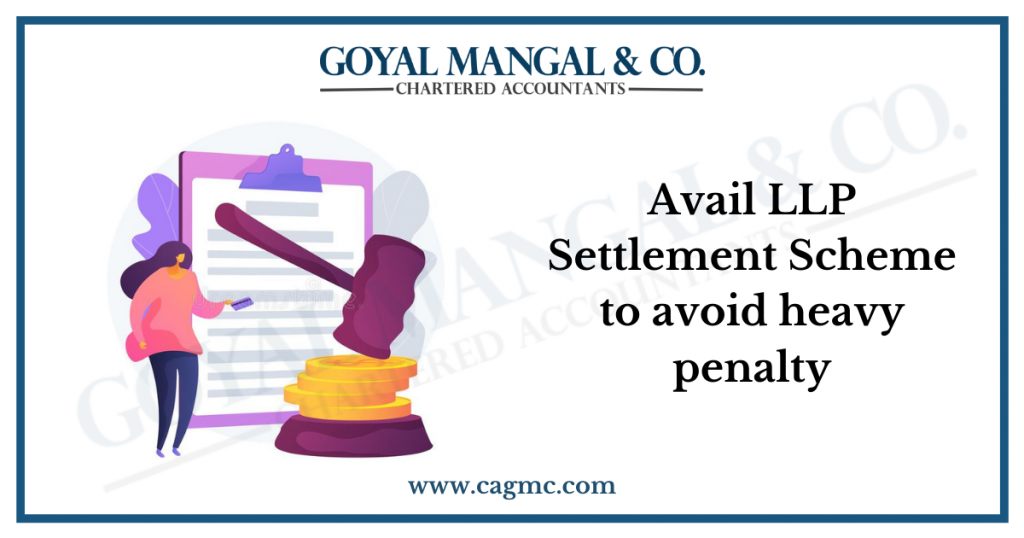
The Ministry of Corporate Affairs (MCA) has changed the law governing the strike-off of Limited Liability Partnerships (LLPs). Because the consequences for failing to file any statutory return are fairly severe, it is prudent for inactive LLPs to close their doors. They can avoid fines by filing applicable forms, and they won’t have to file different LLP forms and Income Tax Returns for each financial year to be in conformity. It would be smart for entrepreneurs to close down LLPs that have been dormant, or have defaulted and are incurring fines. In this article, we’ll discuss Strike off of LLP without Filing of Annual Returns.
Key Abstract
On May 16, 2017, the Ministry of Corporate Affairs issued a notification allowing a Limited Liability Partnership to operate more freely. It states that LLPs that have not carry on their business and have not filed any returns with the relevant registrar and wish to be struck off must file overdue returns for the years in which the LLP was actually in operation. It means that LLPs are exempt from filing returns for periods when the business was not operational. The selected partners must, however, make a declaration on the closure of their business.
Let us discuss about Limited Liability Partnership (LLP), before we move upon Strike off of LLP without Filing of Annual Returns.
What do you mean by Limited Liability Partnership (LLP)?
A Limited Liability Partnership (LLP) is a type of company that gives its participants the benefit of limited liability. It’s a body corporate, and it’s a different legal entity from a business or company. The LLP has the authority to enter into contracts and to purchase property in its own name.
The benefits of an LLP include the ease with which it may be formed, as opposed to a corporation, the restricted responsibility of the partners, the ease with which ownership can be transferred, and the lack of a mandated audit. Another advantage of an LLP is that its tax rate is lower than that of a company.
Is it necessary for a company to file Annual Reports with the ROC before filing an application for LLP strike-off?
The LLP Rules, 2008, clause (b) of sub-rule 1, rule 37, contains the legislative provisions for striking off an LLP. According to the guidelines, there is no exception for filing the e-form (LLP-8 and LLP-11) for LLP strike off. Before an LLP may be strike out, it must file an annual report.
However, there has been a significant shift with the 2017 LLP amendment rules. The amended rules provide that the LLP must file overdue reports in form 8 and form 11 up to the end of the financial year in which the LLP ceased to carry on its business/commercial operations before filing a “strike off” form in clause (b) of sub-rule 1, rule 37.
It implies that LLPs will file late Form 8 and 11 returns until the end of the financial year, in which the LLP’s business or commercial activity ceases. As a result of the amending regulations, an opinion can be formed that if a non-operational LLP wishes to be struck off, it should complete forms 8 and 11 until the end of the financial year in which the concerned LLP ceases to carry on its business or commercial operations.
Is it necessary for a company to file an Initial LLP Agreement with the ROC before filing an application for LLP strike off?
There is no exception from registering an LLP agreement in e-form with the Registrar of Companies in the LLP rule. As a result, before submitting an application for LLP strike-off, you must file the LLP agreement with the registrar of companies.
According to the amendment regulations, if the LLP has not launched its business or commercial operations after its formation, it must send a copy of the initial LLP agreement, as well as any changes to the agreement. As a result, an LLP can make an application for strike off of LLP without filling the e-form (LLP-3) with the registrar of companies if the LLP has been non-operational since its establishment under the requirements of the amendment regulations.
Ways of Striking off of LLP
The following are the procedure for striking of an LLP:
- By declaring the LLP Inactive: If an LLP has not conducted business for a year or longer, or if the LLP wishes to close its doors, it can file an application with the registrar of companies to have the LLP declared defunct and its name removed from the register.
- By winding up of the Limited Liability Partnership (LLP): When a limited liability partnership (LLP) is wound up, the assets of the company are sold to cover liabilities. And any excess is split among the shareholders. There are two ways to wind up an LLP: voluntary winding up and compulsory winding up.
The procedure for Striking Off of LLP
If an LLP has not carried on any business for a year or longer, or if the LLP wishes to close its doors, it can apply to the Registrar of Companies to have the firm declared defunct and the name of the LLP removed from the register of LLPs.
To have the name of the LLP struck off, you must submit an application in e-form 24 with the registrar of companies, together with the necessary documents:
- An account statement notifying no assets or liabilities that has certification by a CA (Chartered Accountant) in practice and is up to date, but not more than 30 days prior to the date of filing of form-24,
- A copy of the most recent Income Tax Return acknowledgment,
- A copy of the first LLP agreement (if one has been entered into but not yet filed), along with any amendments,
- An affidavit signed (jointly or severally) by the named parties indicating that-
- The LLP has not started doing business, or has stopped doing business since that date.
- LLP has no obligations and is responsible for any liabilities that may develop after its name is removed from the register.
- The LLP has not established a bank account, and if one was opened, it has been closed since, with a certificate or statement from the bank indicating that the account has been closed.
- If relevant, the LLP has not filed any Income Tax Returns since its creation since it has not carried on any business.
- A detailed copy of the application, including the entire facts of the LLP as well as the cause for closure,
- All partners’ signatures on a copy of the authorization to file the application.
The LLP’s name can be strike off by the registrar or the LLP itself in Form-24 with the permission of all partners. The registrar will notify the LLP and all of its partners of his intention to remove the LLP’s name from the register after receiving the application. Within 30 days after receiving the notification, he will require that they provide representations together with copies of any necessary documents. After the expiration of the notice period, after the satisfaction of registrar, if no adverse comments from LLP partners or the general public have been receives, will strike the LLP’s name from the register and issue a notice in the official gazette.
Points to Ponder
The following are the points that have to keep in mind:
- There will be no additional questions about the completion of yearly filing if a Limited Liability Partnership (LLP) has completed filing of e-forms (LLP-8 and LLP-11) until the date of strike off. Under rule 37 of the LLP Rules, the LLP may then seek to be strike off.
- If an LLP has filed the e-forms (LLP-8 and LLP-11) for the end of the financial year and has not done any business or carried out any commercial operations since the beginning of the new financial year, the LLP can file an application for strike off of LLP with the Registrar of Companies under the amendment rule, 2017, without having to complete annual filing forms since the time it ceased to carry on its business.
- If an LLP has not completed the e-forms (LLP-8 and LLP-11) since its formation and intends to petition for the provision of strike off under Rule 37, the LLP must complete the yearly filing up to the financial year 2012-2013 under the new regulations. It is critical to be aware that the LLP late filing charge for completing yearly forms is Rs. 100 each day from the date of filing the form till it gets complete.
- This clause has two important aspects: first, an LLP must be non-operational, or not carrying on any business for at least one year, and second, it must be indicated if an LLP filed any annual forms up to the date when it stopped doing business or commercial activities.
Endnote
For enterprises with dormant or failing LLPs, the provision of strike off is a major plus. The LLP Amendment Rules of 2017 have simplified the procedure of winding up a limited liability partnership. The owners can now strike off the LLPs that aren’t working and are racking up fines. The procedure will guarantee that the LLP’s’ owners are not subjected to harsh fines.


